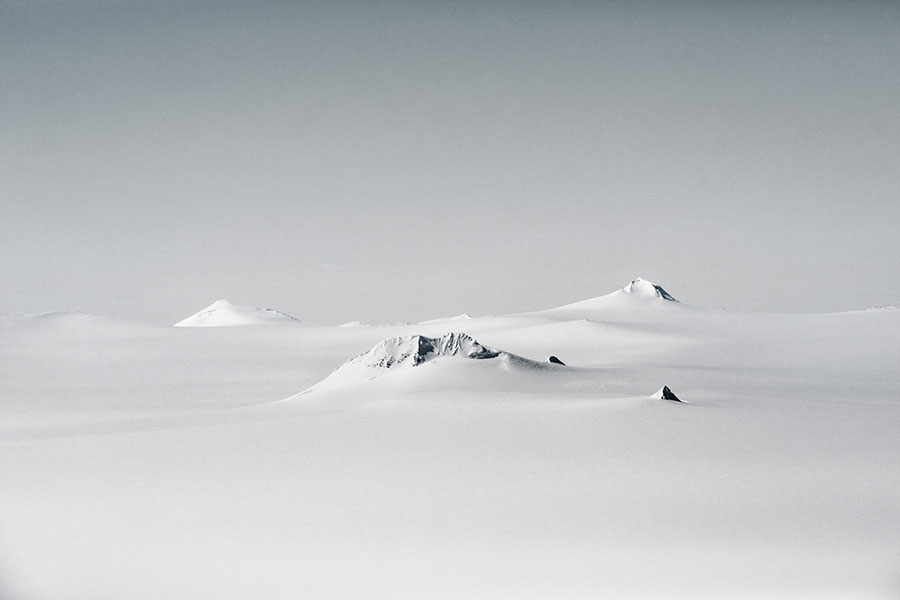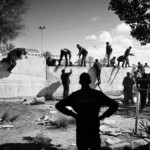Exhibition
in Zürich / Switzerland
- Paolo Pellegrin: NASA IceBridge flight over South Peninsula A, Antarctica, 2017, Archival Pigment Print, various formats & editions
- Paolo Pellegrin: NASA IceBridge flight over Venable 01A, Antarctica, 2017, Archival Pigment Print, various formats & editions
The new series by the Italian photographer Paolo Pellegrin presents to us the stunning natural beauty of the antarctic ice shield, which is simultaneously a site of human-made crisis. The large-scale works on display portray a seemingly intact environment, but at closer observation reveal the eminent danger of being lost to global warming. Pellegrin photographed the antarctic ice fields and glaciers from within a surveying airplane, that is NASA’s annual IceBridge aerial expedition, on their observational flights across the frozen continent. For the first time, his photographs offer a new perspective of Antarctica taken from an altitude of 300 – 500 meter, presenting us with never before seen, detailed and spectacular aerial photographs.
The resulting photographs demonstrate how an almost untouched landscape is yet about to disappear due to our industrial activities elsewhere and reminded us, once more, that environmental crises know no borders. And this is where Paolo Pellegrin draws on his experience as a MAGNUM photographer, having covered many sites of catastrophes, wars and crises. While normally being up-close and embedded, in this personal assignment he steps back to present us with – literally – a bigger picture of a less tangible event: a conflict without noise and visible victims. Yet, a conflict that impacts all of us.
On the other hand, the fact that Pellegrin often photographed this vast white landscape with its icy patterns of cracks and snowy textures without a horizon line call to mind Alfred Stieglitz’ “Equivalents” from a century ago, which are often referred to as the first true abstractions in modern photography. This combination of abstract beauty with the looming destruction elevates Pellegrin’s work to something more than mere visual documents.
- Paolo Pellegrin: Tunisian, Egyptian and other nationals flee Libya during fighting between rebels and pro Qaddafi forces and arrive at the border crossing in Ras Jedir, Near Ben Gardenne, Tunisia, 2011, Archival Pigment Print, various formats & editions
- Paolo Pellegrin: Civilians dig through debris for survivors just moments after an Israeli air strike destroyed several buildings in Dahia, Beirut, Lebanon, 2006, Archival Pigment Print, various formats & editions
On the first Floor: Paolo Pellegrin – Fractured Land
A Selection of Paolo Pellegrins Most Important Crisis and Conflict Photographs
“This is a story unlike any we have previously published. It is much longer than the typical New York Times Magazine feature story; in print, it occupies an entire issue. The product of some 18 months of reporting, it tells the story of the catastrophe that has fractured the Arab world since the invasion of Iraq 13 years ago, leading to the rise of ISIS and the global refugee crisis. The geography of this catastrophe is broad and its causes are many, but its consequences — war and uncertainty throughout the world — are familiar to us all. Scott Anderson’s story gives the reader a visceral sense of how it all unfolded, through the eyes of six characters in Egypt, Libya, Syria, Iraq and Iraqi Kurdistan. Accompanying Anderson’s text are 10 portfolios by the photographer Paolo Pellegrin, drawn from his extensive travels across the region over the last 14 years, as well as a landmark virtual-reality experience that embeds the viewer with the Iraqi fighting forces during the battle to retake Falluja.
It is unprecedented for us to focus so much energy and attention on a single story, and to ask our readers to do the same. We would not do so were we not convinced that what follows is one of the most clear-eyed, powerful and human explanations of what has gone wrong in this region that you will ever read.”
by Jake Silversteine, Editor in Chief, NY Times Magazine
Gallery hours Wed-Fri noon – 6:30 pm, Sat 11 am – 4 pm
Die neuste Serie des italienischen Fotografen Paolo Pellegrin führt uns die Schönheit des antarktischen Eisschildes vor Augen, welches zugleich auch Schauplatz einer von Menschen verursachten Krise ist. Die grossformatigen Luftaufnahmen zeigen imposante Bilder einer scheinbar intakten Umwelt. Erst bei genauerem Betrachten erahnen wir – gespiegelt durch die dramatischen Veränderungen der Landschaft – den bevorstehenden Verlust, der uns durch die Erderwärmung droht.
Pellegrin hat die Eisfelder und Gletscher aus einem Forschungsflugzeug der NASA fotografiert, die auf ihrer jährlichen IceBridge-Expedition Messflüge über dem Kontinent durchführt. Die Antarktikis von oben, diese Perspektive kannten wir bis anhin nur von Satellitenbildern. Zum ersten Mal liefert nun ein Fotograf Bilder aus einer Flughöhe von nur 300 bis 500 Metern über dem Eis und schenkt uns damit nie gesehene, detaillierte und spektakuläre Luftaufnahmen.
Die ausgedehnten Landschaften mit ihren Mustern in Eis und Schnee, meist ohne Horizont fotografiert, erinnern gleichzeitg aber auch an die “Equivalents” von Alfred Stieglitz, die dieser vor hundert Jahren fotografiert hat und die gemeinhin als erste Abstraktionen der modernen Fotografie gelten. Diese Verschränkung aus abstrakter Schönheit der fotografierten südpolaren Landschaft und der politischen Dringlichkeit ihrer drohenden Zerstörung erhebt die Arbeit von Paolo Pellegrin weit über das reine Bilddokument hinaus.
Diese Fotografien demonstrieren, wie eine fast unberührte Landschaft langsam verschwindet, wegschmilzt, verursacht durch unsere geographisch weit entfernten industriellen Aktivitäten. Einmal mehr werden wir daran erinnert, dass Umweltprobleme keine Grenzen kennen. Und genau hier setzt der Magnum-Fotograf an, der bisher vor allem in Krisen- und Kriegsgebieten gearbeitet hat. Während er normalerweise auf Tuchfühlung und ins Geschehen eingebettet Bilder produziert, tritt er hier einen Schritt zurück und zeigt uns das grosse Ganze eines schwer fassbaren Vorgangs: einen Konflikt, der ganz im Stillen passiert – ohne sichtbare Opfer. Einen Konflikt, der uns alle betrifft.
Paolo Pellegrin wurde 1964 in Rom geboren. Er studierte Architektur an der Universität la Sapienza in Rom bevor er zum Fotografiestudium am Instituto Italiano di Fotografia wechselte. Er gilt als einer der wichtigsten Konfliktfotografen der Welt.
Zwischen 1991 und 2001 wurde Pellegrin von der Agentur VU in Paris vertreten. Seit 2005 ist er Vollmitglied bei der weltbekannten Fotografenagentur Magnum. Er war als Fotograf während 10 Jahren bei der Zeitschrift “Newsweek” unter Vertrag. Pellegrin gewann unzählige Preise: darunter 10 World Press Photo Awards, den Hansel-Meith-Preis und die Robert Capa Gold Medal. 2006 wurde ihm der W. Eugene Smith Grant in Humanistischer Fotografie verliehen.
Seine Buchpublikationen sind u.a.: “100 Photos of Paolo Pellegrin” for Press Freedom (Reporters Sans Frontières, France, 2013); “Dies Irae” (Contrasto, Italy, 2011); “Photo Poche” (Actes Sud, France, 2010); “As I Was Dying” (Actes Sud, France, 2007); “Kosovo” 1999-2000: “The Flight of Reason” (Trolley, USA, 2002); “Cambogia” (Federico Motta Editore, Italy, 1998) und “Bambini” (Sinnos, Italy, 1997).
Paolo Pellegrin lebt mit seiner Familie in Genf.
Im ersten Stock: Paolo Pellegrin – Fractured Land
Eine Auswahl von Pellegrins wichtigsten Krisen- und Konfliktfotografien.
Öffnungszeiten Mi-Fr 12 – 18.30 Uhr, Sa 11 – 16 Uhr
Location:
Bildhalle
Stauffacherquai 56
8004 Zürich
Switzerland





